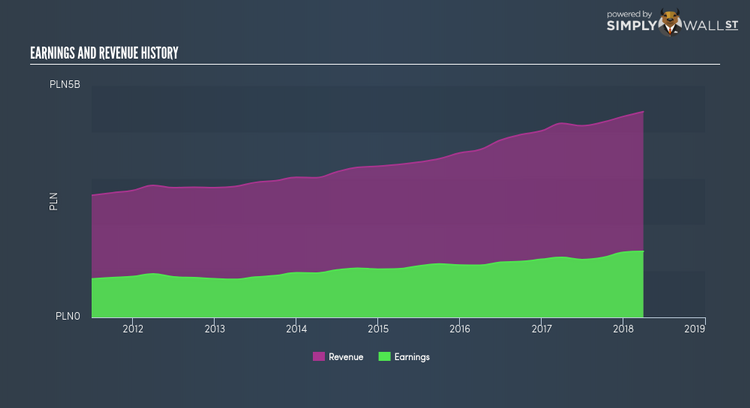Want To Invest In ING Bank Slaski SA. (WSE:ING)? Here’s How It Performed Lately

Measuring ING Bank Slaski SA.’s (WSE:ING) track record of past performance is a useful exercise for investors. It enables us to understand whether or not the company has met or exceed expectations, which is an insightful signal for future performance. Today I will assess ING’s recent performance announced on 31 March 2018 and weigh these figures against its long-term trend and industry movements. View our latest analysis for ING Bank Slaski
Were ING’s earnings stronger than its past performances and the industry?
For the purpose of this commentary, I like to use data from the most recent 12 months, which either annualizes the most recent 6-month earnings update, or in some cases, the most recent annual report is already the latest available financial data. This method enables me to assess different companies on a similar basis, using new information. For ING Bank Slaski, its most recent trailing-twelve-month earnings is ZŁ1.43B, which, relative to last year’s level, has risen by 10.13%. Given that these values may be relatively short-term, I have created an annualized five-year figure for ING Bank Slaski’s earnings, which stands at ZŁ1.06B This shows that, on average, ING Bank Slaski has been able to steadily raise its earnings over the past few years as well.
How has it been able to do this? Let’s see whether it is solely owing to industry tailwinds, or if ING Bank Slaski has experienced some company-specific growth. Over the last few years, ING Bank Slaski grew its bottom line faster than revenue by effectively controlling its costs. This resulted in a margin expansion and profitability over time. Scanning growth from a sector-level, the PL banks industry has been growing, albeit, at a muted single-digit rate of 6.56% over the previous twelve months, and 3.09% over the past five. This suggests that whatever uplift the industry is benefiting from, ING Bank Slaski is able to amplify this to its advantage.
What does this mean?
While past data is useful, it doesn’t tell the whole story. While ING Bank Slaski has a good historical track record with positive growth and profitability, there’s no certainty that this will extrapolate into the future. I recommend you continue to research ING Bank Slaski to get a better picture of the stock by looking at:
Future Outlook: What are well-informed industry analysts predicting for ING’s future growth? Take a look at our free research report of analyst consensus for ING’s outlook.
Financial Health: Is ING’s operations financially sustainable? Balance sheets can be hard to analyze, which is why we’ve done it for you. Check out our financial health checks here.
Other High-Performing Stocks: Are there other stocks that provide better prospects with proven track records? Explore our free list of these great stocks here.
NB: Figures in this article are calculated using data from the trailing twelve months from 31 March 2018. This may not be consistent with full year annual report figures.
To help readers see pass the short term volatility of the financial market, we aim to bring you a long-term focused research analysis purely driven by fundamental data. Note that our analysis does not factor in the latest price sensitive company announcements.
The author is an independent contributor and at the time of publication had no position in the stocks mentioned.

 Yahoo Finance
Yahoo Finance 
